When Worse Comes to Worst: The Black Hole and Saturn 3
The Black Hole (Disney, 1979)
Stephen Spielberg may have said that “the arc of the cinematic universe is long, but it bends towards quality,” but that’s a crock. (Actually, he didn’t say that. No one did. But I need to establish something here, so cut me some slack, will you?) Much as we may wish otherwise, cinema history, like the other, capital H kind, isn’t linear or progressive – it’s cyclical. This means that there will be times when things are trending up and times when they’re heading down, periods of boom and periods of bust, seasons when excellence commands the stage and epochs when utter crap towers so high over everything that it blots out the sun. Perhaps no film genre demonstrates this inevitable ebb and flow better than science fiction.
Never was this more evident than during the late 70’s and early 80’s, a low end of the bell curve era if there ever was one. For every Star Wars or Alien, there was a Metalstorm or a Spacehunter. Actually, given the iron logic of Sturgeon’s Law (“Ninety percent of everything is crap”), for every Empire Strikes Back there were nine (!) Laserblasts. In fact, you could argue that this arid stretch invalidates the law altogether – by proving Sturgeon wildly optimistic. Ninety percent? Anyone who spent time in the mall multiplexes during those years could be excused for thinking that the offal percentage was closer to ninety-nine than ninety.
(By the way, if you think I’m being unduly hard on these films, we can easily talk about some of the era’s other cultural products. How about music? Where shall we start – Martha Davis and the Motels? A Flock of Seagulls? Loverboy? Yeah… that’s what I thought. Back to crappy sci-fi movies it is.)
The years when Jimmy “I will never lie to you” Carter was lying stunned on the table while Ronald “Aw, shut up!” Reagan was bursting through his chest were a treasure trove of celluloid SF awfulness; movies like Krull, Meteor, and Battle Beyond the Stars established a schlock standard that will likely never be exceeded, and is perhaps matched only by the rampant radiation/big bug/rubber-suit monster apogee of the mid 50’s. But while the warm glow that emanates from that decomposing mid-century trash has appreciably faded over the years, the choking stench of late 70’s – early 80’s fantastic cinema still hovers over the pop-cultural landscape like a cloud of toxic smoke over a burning garbage dump.
So…let’s stick our noses in and inhale deeply, shall we?
Star Wars (1977)
The out of nowhere success of Star Wars in 1977 jolted Hollywood like a cattle prod, shocking executives into a new awareness: science fiction, which until then had mostly been a low rent, b-movie, Saturday afternoon serial affair, was actually capable of generating unbelievably huge profits. Since Star Wars had a relatively modest budget and no big stars to speak of (Alec Guinness was a great actor but not a big star, at least not in America), the studio chiefs naturally decided that they could replicate and even improve on George Lucas’s achievement by upping the budget and/or getting bigger names for their science fiction films. These improvements would guarantee so much profit that they would have to hollow out Mount McKinley to store all the cash. What could go wrong?
The Black Hole and Saturn 3, that’s what. Both of these movies show how easy it is to learn the wrong lessons from someone else’s success. As such, they offer museum-quality examples of five mistakes commonly made in the post Star Wars era by dunderheaded movie makers, imagination-deficient copycats who understood only one thing about their model: it made a lot of money.
These blunders fall into five categories: Let’s cast good actors and then humiliate them; In space, no one can hear the dialogue, so it’s OK if it’s terrible; Every story is better with a dollar-store Darth Vader; Impossibly anthropomorphic robots with cloyingly cute accents delight viewers of all ages so let’s have even more of them (an error I have dubbed the Twiki Factor – how could I not?); and your favorite and mine, Science? We don’t need no stinking science!
1979’s The Black Hole was one of the first major movies to directly show the influence of Star Wars and being a Disney production, it had twice the budget that Lucas’s film had. Also, theoretically the cast had a lot more gravitas than the Star Wars ensemble of up and comers did, but in the event the waning wattage generated by this bunch barely lit up a broom closet, largely because by 1979 most of them had hung around well past their sell-by date.
The roster includes moth-eaten Maximillian Schell (Best Actor 1961) as the movie’s obligatory incarnation of ambition and madness, Dr. Hans Reinhardt, moldy old Ernest Borgnine (Best Actor 1955) as the rough-edged space prole Harry Booth, and panic attack prone Anthony Perkins (the hot young star of 1957) as the idealistic but only partially defrosted Dr. Alex Durant.
Anthony Perkins and Yvette Mimieux in The Black Hole
Those are the biggies. It’s not even worth mentioning the microscopic drawing power of Time Machine veteran Yvette Mimieux (still suffering from Morlock Shock) as Dr. Kate McCrae, Joseph Bottoms (neither an up and comer nor a has-been – more like a back-of-the-fridge Tupperware full of leftovers from a meal that wasn’t that good in the first place) as Lieutenant Charles Pizer, and Robert Forster (perhaps the best actor of the bunch, but Jackie Brown and Breaking Bad were still light years away) as Captain Dan Holland.
The movie’s perfunctory plot deals with the deep space exploration vessel Palomino, which in its search “to discover habitable life in outer space” stumbles (in the dark, as it were) over a black hole and, right next to this “rip in the very fabric of space and time,” the Cygnus, a ship that’s been missing for twenty years. Boarding the mystery ship, the crew of the Palomino discovers that the vessel’s captain, the legendary Dr. Hans Reinhardt, is still at the helm, his grating German accent and Prussian habits of command miraculously intact after all these years. I don’t know what the good doctor was like back in his salad days at Gamma U, but by the time our heroes meet him he’s an eyeball-rolling nut. (He also dresses like the maître d’ at a cheap Italian restaurant.)
Hans Reinhardt – Table for Two
Reinhardt is determined to take the Cygnus straight through the black hole, which in the hands of Disney’s crack special effects team looks just like a sinkfull of dirty, potato peel-flecked water slowly making its way down a clogged drain. Harry Booth declares that if Happy Hans can bring off this suicidal feat, he “will solve the one final mystery that has eluded mankind – or he’ll die in the attempt on a glorious pilgrimage straight into what may be the mind of God.” This is what happens when you fall asleep in your astrophysics class and wake up in the middle of a comparative religion lecture.
Reinhardt and his ship should have been dragged into the black hole years ago anyway, especially as the phenomena seems to hover just a stone’s throw off the port bow. How has the Cygnus been able to defy the unbreakable laws of physics and resist the collapsed star’s crushing gravitational forces for two decades? The doctor’s glib explanation would make Stan Lee blush: “We developed anti-gravity forces to maintain our position – it’s what you might call a Mexican Standoff.” Just tinkered it together in the garage on spare weekends, I suppose.
The Cygnus
Reinhardt is the only human being left on his huge ship, as he has long since turned the original human crew into mute cyborg slaves through a goofy transmogrification process that Mimieux’s Kate McCrae barely escapes. Once Captain Holland and the rest realize that Hans is one of those bad Germans you hear so much about, the rest of the movie is taken up with a lot of running and ducking and hiding, with the occasional pause for one-sided laser battles (just like the Storm Troopers in Star Wars, Reinhardt’s cyborgs couldn’t hit the broad side of a Star Destroyer).
The only relief from this ruckus comes when a meteor five stories high somehow breaks into the Cygnus and rolls the length of the ship like a gigantic bowling ball while everyone frantically scrambles to get out of its way. I would accuse the filmmakers of stealing this scene from Raiders of the Lost Ark but that movie wouldn’t be made for two more years. It’s actually a pretty impressive sequence – visually. Scientifically? Excuse me – I have to take this phone call…
The meteor
Forster, Bottoms, and Mimieux manage to evade cyborgs, meteors, and their agents’ panicked phone calls and make it off the Cygnus and back to the Palomino before the crazed Reinhardt takes his ship into the black hole. (The casualties are Ernest Borgnine, who turns out to be a despicable, save-yourself-first coward, thus earning the movie a few points for psychological realism, and Anthony Perkins, who bowed out early because he had some dry cleaning to pick up). Instrumental in this escape are two characters I’ve avoided mentioning so far, but some things can’t be put off forever.
V.I.N.CENT and B.O.B.
V.I.N.CENT. (Vital Information Necessary Centralized – really!) and B.O.B (Bio-Sanitation Battalion – hey, if you think coming up with acronyms is so easy, you try it) are two helpful, humorous, oh-so voluble robots guaranteed to delight audiences everywhere – as long as those audiences are made up of children too young to understand the difference between human beings and Volkswagens.
V.I.N.CENT. (voiced by Roddy McDowall) is a crew member of the Palomino and is apt to say things like, “There are three basic types, Mr. Pizer: the Wills, the Won’ts, and the Can’ts. The Wills accomplish everything, the Won’ts oppose everything, and the Can’ts won’t try anything.” That’s when he’s not quoting Cicero or boasting about the unimprovable perfection of his model. I’m not sure whether they told McDowall to double the snooty/snippy quotient for this movie or cut it in half. Either way, after five minutes you want to take a blowtorch to his tin butt.
Maximillian
On the other hand, B.O.B. is a down-home, just-folks machine who doesn’t get the love from Reinhardt and the Cygnus cyborgs that he deserves. (His primary nemesis is Reinhardt’s number-one henchman, Maximillian, a hulking, menacing red robot. Maximillian is just like Darth Vader – except he doesn’t sound like James Earl Jones. He doesn’t sound like anyone, since he has no lines. Disney chose some odd places to economize.) B.O.B. is voiced by… Slim Pickens. B.O.B. does not quote Cicero. What does he say? The sorts of things Slim Pickens would say while playing a heroic and tragic part in a wide-screen science fiction adventure that ends with him being sucked into a black hole, OK? Can we just leave it at that?
Neither McDowall nor Pickens took any screen credit for their work on The Black Hole. They knew that on projects like this, the smartest thing is to take the money and run. While cashing their checks, doubtless McDowall sourly quoted a poem by Catullus and Pickens said something like, “This ain’t my first time at the rodeo!”
The bots aren’t even the most painful things about the movie; that distinctionis reserved for its absurd metaphysical pretensions. On first catching sight of the black hole, Borgnine blurts, “My God! Right out of Dante’s Inferno!” This prompts Bottoms to respond, “Every time I see one of those things, I expect to spot some guy in red with horns and a pitchfork.”
These statements establish that recreational hallucinogens have been decriminalized in whatever century this is supposed to be while also nicely setting the stage for the movie’s Big Finish, when Reinhardt and the Cygnus pass through the black hole (which when it finally happens looks like an acid trip as pictured on the old Dragnet TV show) and emerge… wait for it… in Hell, complete with fire and sulphureous fumes and black-robed lost souls and guardian demons that look exactly like the evil red robot, Maximillian, which is the entry-level position that Reinhardt is seemingly destined to fill… forever.
The Palomino and its remaining crew get pulled into the hole too (they didn’t develop anti-gravity forces to maintain their position, after all) but since they’re nice people, they go through a long sparkly glass hallway in space that’s like something out of a perfume commercial and wind up by some planet somewhere that looks sort of heavenly, whatever that might mean. Are they dreaming? Are they dead? Do you care? In any case, you’ve earned your reward – that moment you’ve suffered through so much to reach, when The End finally appears on the screen. It might not be the beatific vision, but damn, you’re glad to see it.
As Ernest Borgnine so succinctly said, “My God!”
The Black Hole made thirty-five million dollars. With a budget of twenty million, this was a decent profit but nothing to write home about, considering that the goal was Star Wars level profits (four hundred and sixty million dollars on a budget of eleven million). Why didn’t The Black Hole replicate its model’s success? Because it mostly sucked (like a black hole – get it?) and Star Wars didn’t. Lesson learned? We’ll see.
As is the way of things, 1979 was followed by 1980, and as rout follows retreat, The Black Hole was followed by Saturn 3.
Saturn 3 (1980)
Where The Black Hole aspired to epic spectacle, Saturn 3 is more of a chamber piece, featuring as it does only three characters cooped up in one claustrophobic location. Adam (Kirk Douglas) and Alex (Farrah Fawcett) work together deep under the surface of a nameless moon of Saturn, or maybe it’s an asteroid (if you had asked the filmmakers which, they doubtless would have replied, “Huh?”), in the subterranean chambers and tunnels of the Saturn 3 Research Station. (The striking sets make it seem as if the whole story is taking place in an enormous lower intestine, which is quite appropriate. Early on, Douglas says of Saturn 3: “When they want to give the solar system an enema, that’s where they stick the tube in!” Later he declares that “People are being flushed all over the system!” Do you see – or perhaps I should say, smell – a theme here? And yes, everything Kirk Douglas says in this movie ends with an exclamation point, whether it needs to or not.)
Adam and Alex spend their days striving to create new food sources for a hungry and overpopulated Earth… that is, when they’re not playing slap and tickle during their long showers together or walking around wearing nothing but towels or getting sweaty playing Twister under the sheets. Douglas was sixty-four years old (hard years too, by the look of it) and Fawcett was thirty-three when the movie was made. I’m as broadminded as the next person (actually, it depends on who the next person is) but honestly… it’s kind of icky.
Icky
Icky or not, their idyll is broken up by the arrival of the sullen and psychopathic Benson (Harvey Keitel, still in a bad mood after getting canned from Apocalypse Now, and his mood didn’t get any better after Saturn 3 wrapped and he found out that the director had all of his dialogue redubbed because he didn’t like Keitel’s New York accent). For reasons that are never made clear, Benson surreptitiously took the place of the fellow who was supposed to come to Saturn 3. (He murdered him by shoving him out of an airlock after the guy mildly joked about Benson failing his mental stability test. Yep, just like everyone else associated with this film.)
Benson and Hector
Benson has supposedly arrived to help Adam and Alex with their behind-schedule work (“Earth is hungry,” he laconically explains), but once he’s exchanged a little small talk, he immediately mounts a two-front attack: he begins unpacking and assembling a huge robot that he brought with him while simultaneously putting the moves on Alex, which leads to sparkling exchanges like this:
Alex: It’s time we get to bed, Captain.
Benson: Yes, you have a great body. May I use it?
Alex: I’m with the major.
Benson: For his personal consumption only?
Alex: Yes.
Benson: That’s penally unsocial on Earth, you know that?
Alex: Well, it’s not here. Enjoy your blues.
Where’s Ernest Borgnine when you need him? By the way, blues are some sort of recreational drug that Keitel has brought with him from Earth. This drug angle gets a big build-up but turns out to have no effect on the story whatsoever, though a narcotic-induced dream sequence was filmed that featured Farrah in a sort of outer space chambermaid outfit. The scene got cut before release, probably because of its excessive realism.
The Drug Dream
In no time Benson has cobbled together his robot – Hector (no acronym, thank God, just Hector), “The first of the Demigod series.” And here’s where it really gets weird. Hector (seven feet tall, bulked up like a tin Stallone, but with an itty-bitty head, which pretty much spoils the effect) comes out of the box a blank slate. Benson has to teach him everything he will need to know. The method employed is “direct input” – Benson has a sort of USB port in the back of his neck; when he isn’t using it to groove to the Bee Gees or ABBA (that’s what I’d do with it, anyway), he’s using it for “brain to brain” teaching, filling it with whatever he has sloshing around in his own head at the moment and then plugging it into Hector for transfer to the robot.
Robot rampage in Startling Stories
However, since Benson is a murderous lunatic with an uncontrollable yen for Alex, Hector quickly becomes… a murderous lunatic with an uncontrollable yen for Alex. A lustful robot on the rampage?! Asimov save us! 1980 my foot – these people stole their plot from a 1950 copy of Startling Stories.
Farah Fawcett in happier days
Tensions mount as Harvey sulks, Kirk grimaces, and Farrah wonders if Kate Jackson and Jacqueline Smith could be persuaded take her back, and it all comes to a head in the infamous nude wrestling scene. After Hector goes berserk and is dismantled (temporarily – he puts himself back together when no one is looking), Benson barges in on Adam and Alex to tell them he’s leaving. He finds them in bed together (surprise!) and declares that he’s taking Alex with him, whether she wants to go or not. “Doesn’t it disgust you to be used by him – to be touched by an old man?” he sneers, and before Alex can sob, “God, yes!” a bug-eyed, buck-naked Adam launches himself at his rival.
Words fail me
Kirk and Harvey thrash around for quite a while until Farrah separates them. Camera angles are carefully chosen – for which I’m eternally grateful – but before it’s over, Kirk Douglas has truly shown us what he’s made of. (Keitel and his therapist should finally be done working through this episode sometime in the spring, and will at last be able to deal with the actor’s lesser life traumas.)
Forget the robot and the spaceships and the rings of Saturn – the movie’s most startling special effect is a brief but not brief enough glimpse of the saggy, mottled buttocks of a not even middle-aged anymore Kirk Douglas as he staggers away from the camera after the fight is over. (Available data indicates that eighty percent of the audience exited the theater for the candy counter during this scene and never returned, and lines at the bathrooms went out the door and around the block.)
Before things can get any more awkward, Hector arrives and sends the movie into its “irreversible orbit decay” phase. The rogue robot imprisons Adam and Alex in separate rooms, letting them out only to follow his inflexible dictates, decapitates (and then inexplicably mentally merges with) Benson, and finally lumbers into a fatal trap that Adam sets for him. (Adam jumps on Hector and blows both himself and the robot up with a bomb that he rigged. Earlier Adam had defeated Hector at chess by giving up a piece, saying that the one thing you can’t teach a robot is sacrifice, just like the one thing you can’t teach an actor is to pass on a godawful movie even if the bank balance is getting low.)
The story ends with Alex and her completely new hairdo (obviously the relationship she was most invested in) returning to Earth, which we see in a startlingly inept final shot. (Saturn 3 boasts special effects that are quite bad; some of them are not much above Ed Wood level. The Black Hole comes out ahead in this department because it was merely uneven – some effects were meh, but others were truly spectacular.)
The movie’s publicity campaign featured ads and posters emblazoned with the phrase “Some Thing is wrong on Saturn 3,” which almost qualifies as truth in advertising – almost, but not quite, because it turned out that everything was wrong: director, cast, and script. They would have done better putting something like this on the poster: “SEE! Two seconds of Farrah Fawcett’s bare right breast!” (It’s getting hard to remember now, but adolescent boys passed such moments around like holy relics in those pre-internet days.)
It wouldn’t have helped anyway. If The Black Hole has too many problems to reasonably be called good, Saturn 3 is far beyond bad. It’s a cinematic root canal, a stupefyingly awful experience. Ernest Borgnine had the last word on his movie, and Farrah has it on hers: “It’s hopeless.” It’s the only line in the whole film that she says with any genuine feeling.
It should not have been this bad. While The Black Hole was helmed by Gary Nelson, who spent his career largely in television, polishing gems like Gilligan’s Island, Nanny and the Professor, and Gomer Pyle: USMC, Saturn 3 had a real movie director, Stanley Donen, who had some classic films to his credit – Royal Wedding, Singin’ in the Rain, Seven Brides for Seven Brothers, The Pajama Game, and Damn Yankees among them. Attentive readers will note, however, that all of those movies are musicals, while even the least attentive viewer will quickly notice that Saturn 3 is not. Obviously, it’s easier to get Gene Kelly and Fred Astaire to dance brilliantly than it is to make undercooked tripe like Saturn 3 palatable. A decent screenplay would have helped, but the amount of time spent crafting a tight, coherent script was apparently smaller than the brassiere budget on Charlie’s Angels.
Speaking of which, Farrah Fawcett, who jumped ship after one season on that quintessential “Jiggle” show, got top billing over Spartacus himself. The most depressing thing about Saturn 3 is seeing Kirk Douglas, the man who played Colonel Dax in Kubrick’s Paths of Glory, who went toe to toe with Laurence Olivier in The Devil’s Disciple and Spartacus, who burned a hole in the screen in Detective Story and Ace in the Hole, mugging his way through a piece of junk like this.
Hydroponics…hydroponics…
In one scene, Douglas has Farrah slowly disrobe while he demonstrates his self-control by saying “Hydroponics…hydroponics…hydroponics…” until he breaks down and, giggling maniacally, flings himself at her, bathrobe flapping. I love you, Spartacus, but please! It always took a strong director to keep Douglas from becoming a parody of himself, and poor Stanley Donen was too busy trying to figure out this nutty “science fiction” stuff to keep a tight rein on his star – or even to keep him minimally clothed. It’s sad.
Sadder still was the producer, Lew Grade (or Low Grade, as many in the business called him), who saw this sure-fire money machine fail to even return its costs; in a development that should have surprised no one, Saturn 3 was a financial black hole that lost rather than made money.
Lucas envy
In the end, the main trouble with both movies is that they suffer from a debilitating case of what space-cinema psychiatrists could only call Lucas Envy. From the bombastic John Williams-flavored overture that starts The Black Hole (does a movie that barely cracks an hour and a half need an overture?) and the laser battles that punctuate it, to the opening shot of Saturn 3, where an enormous spaceship slides across the screen with agonizing slowness, for no other purpose than showing an enormous spaceship sliding across the screen with agonizing slowness, these movies desperately wanted to be Star Wars… and they just weren’t. Ultimately, they didn’t fool anyone, not even the accountants. (Especially not the accountants.)
An almost fatal case
If they serve no other purpose, at least The Black Hole and Saturn 3 are incontrovertible proof that Lucas Envy is nothing to be laughed at or taken lightly; it can be a very serious malady indeed – hell, it damn near killed George Lucas.
Thomas Parker is a native Southern Californian and a lifelong science fiction, fantasy, and mystery fan. When not corrupting the next generation as a fourth grade teacher, he collects Roger Corman movies, Silver Age comic books, Ace doubles, and despairing looks from his wife. His last article for us was Doors Open, Doors Closed: Alan Garner’s Elidor.
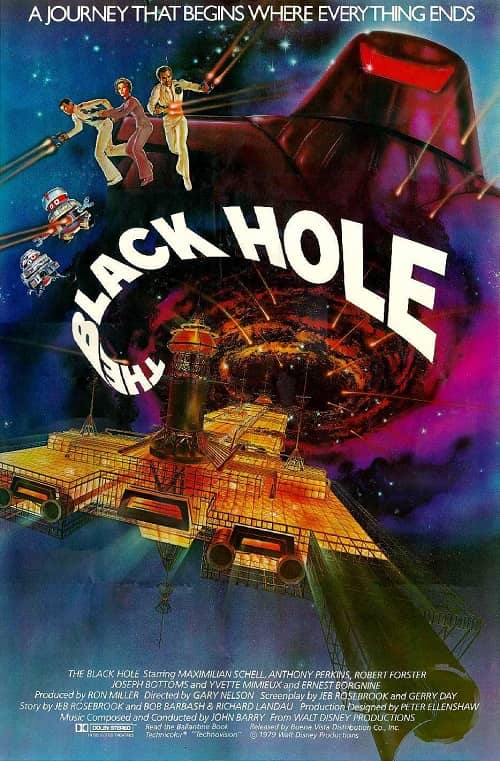
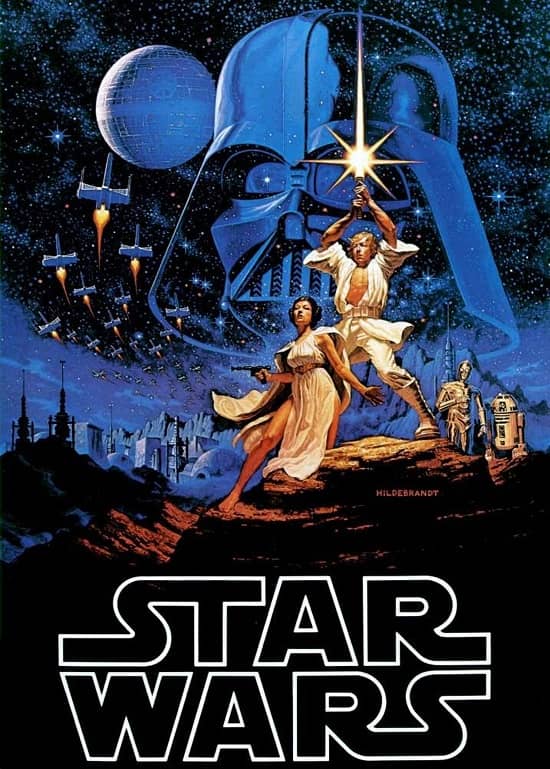
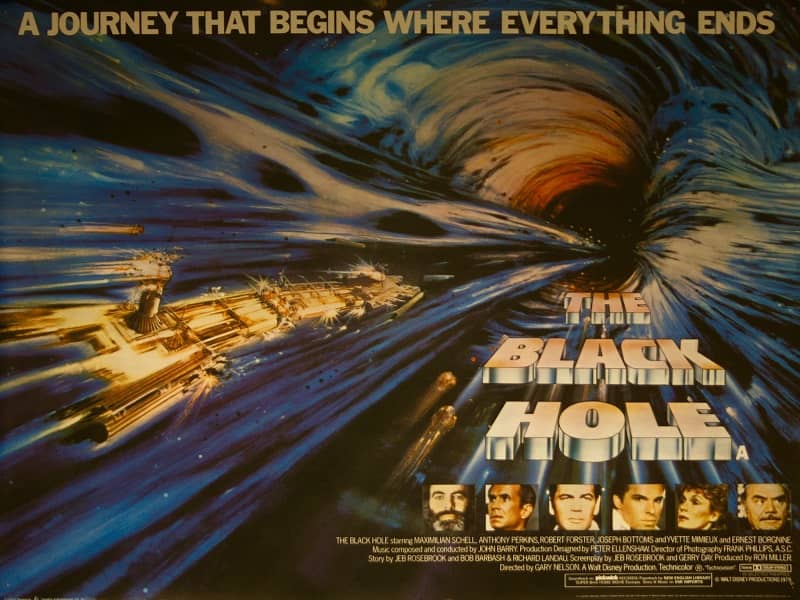
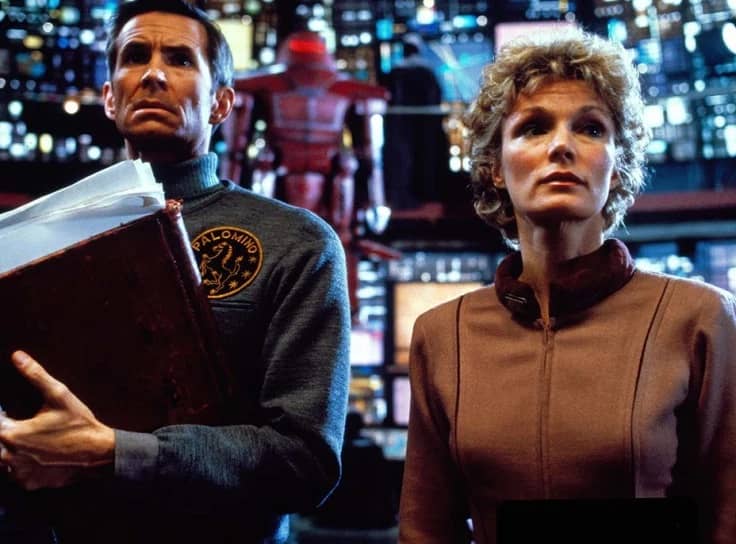
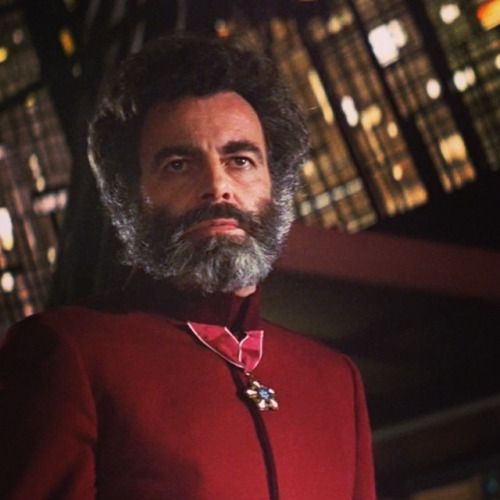
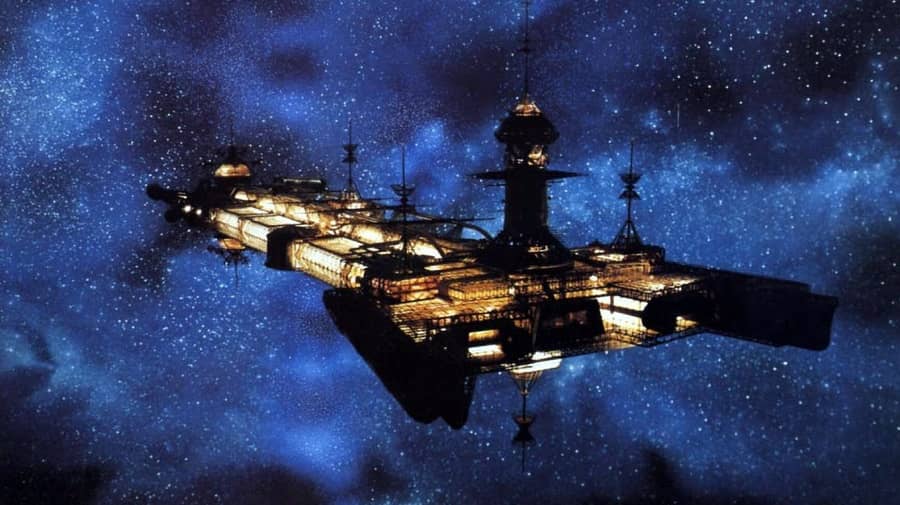
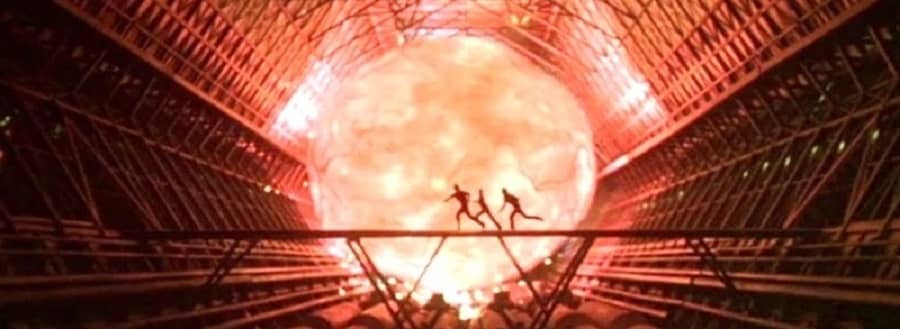
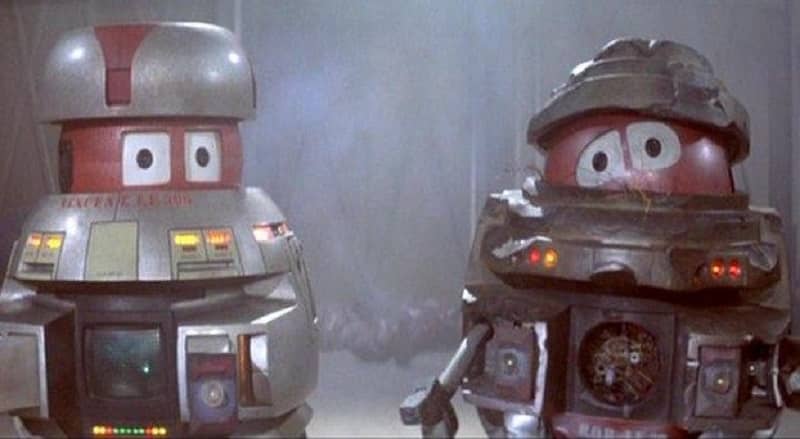
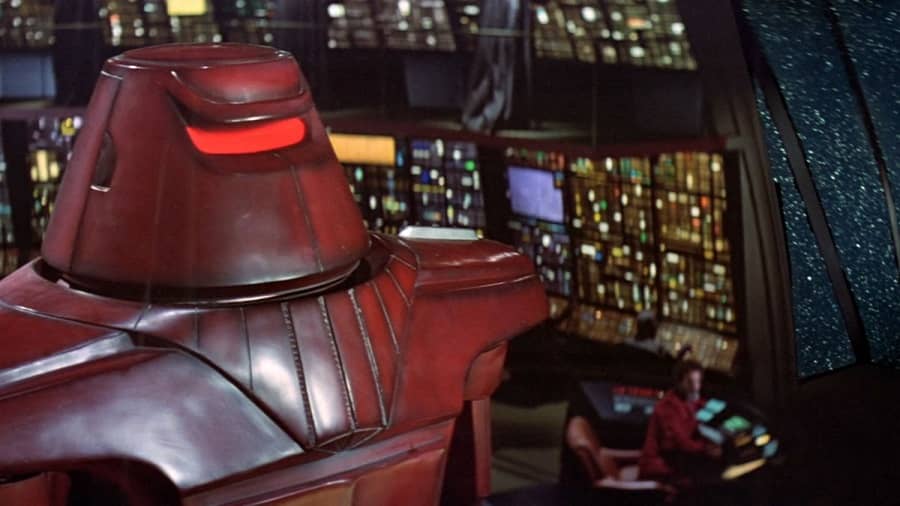
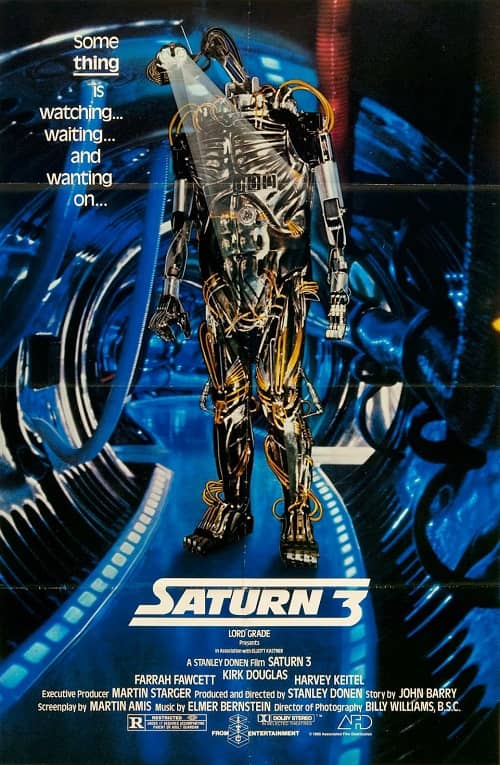
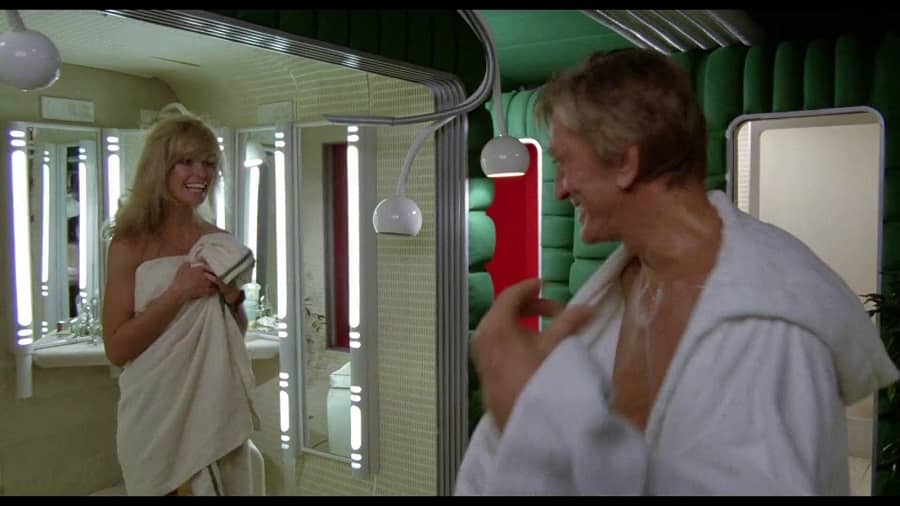
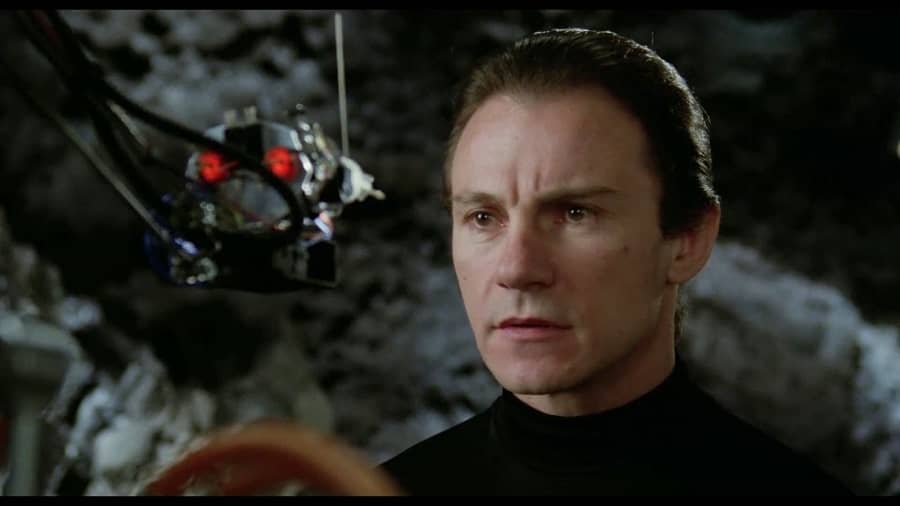
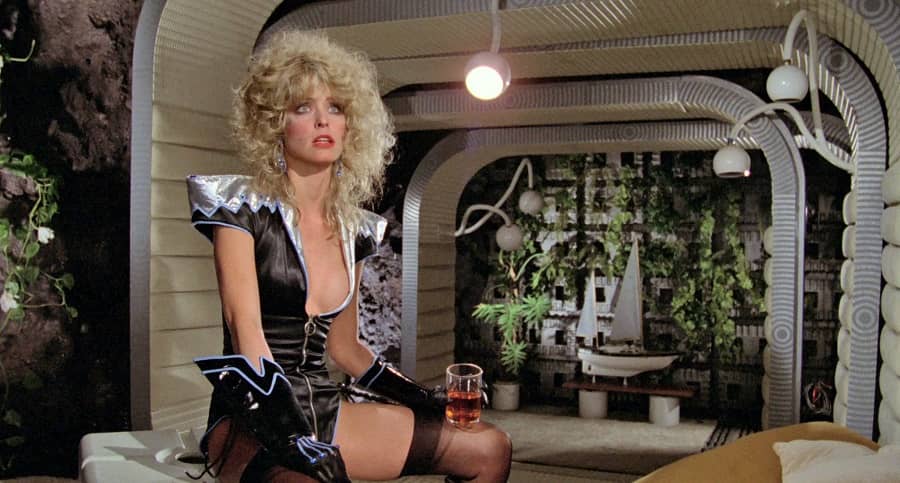
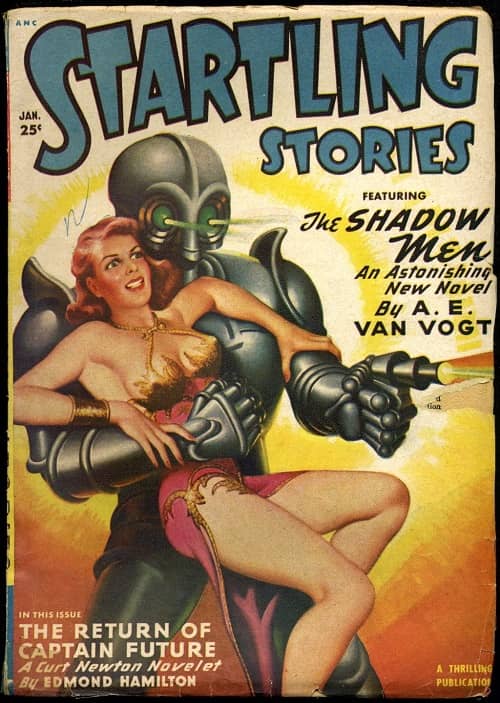
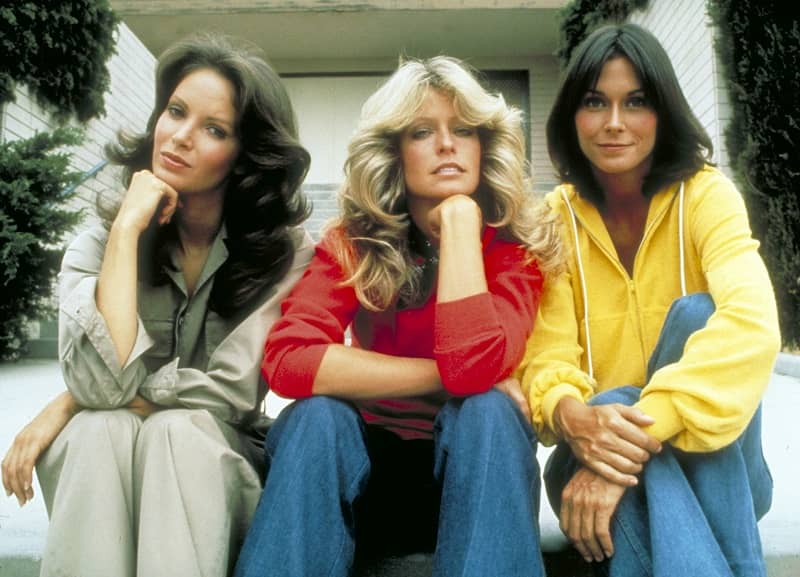
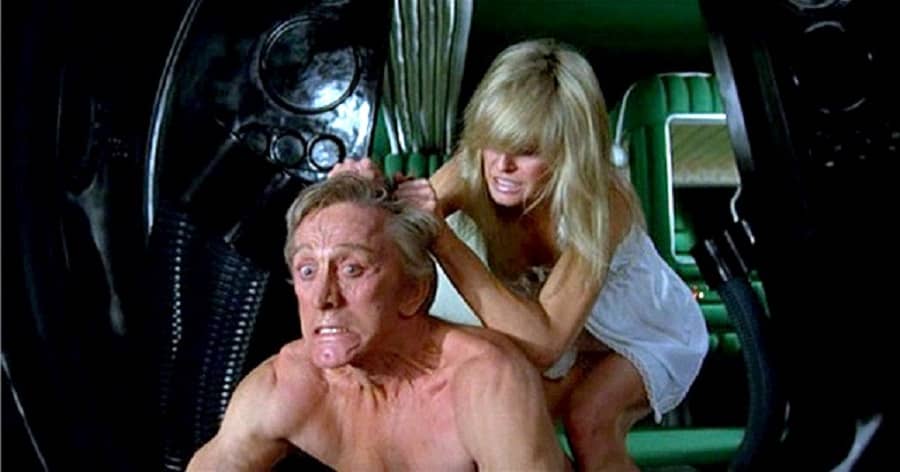
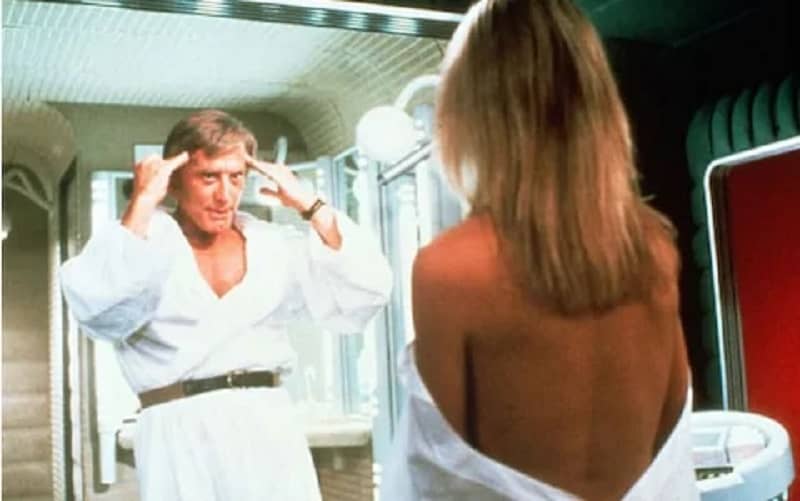
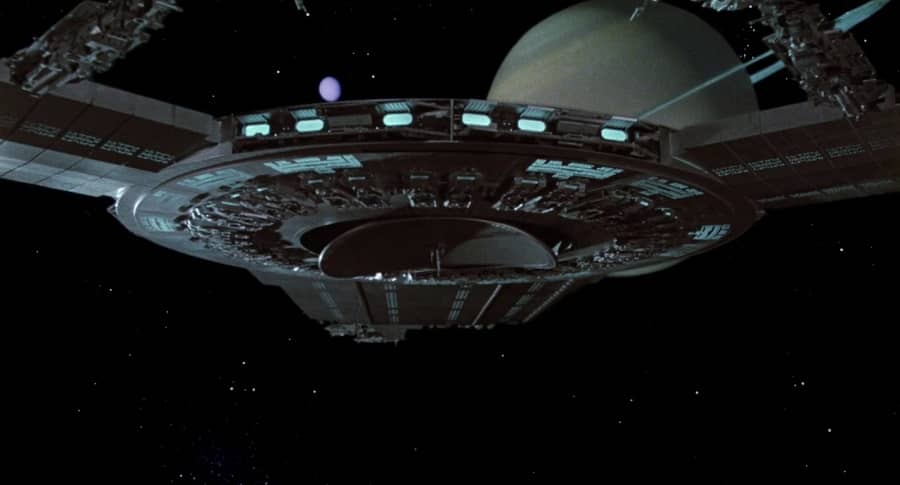
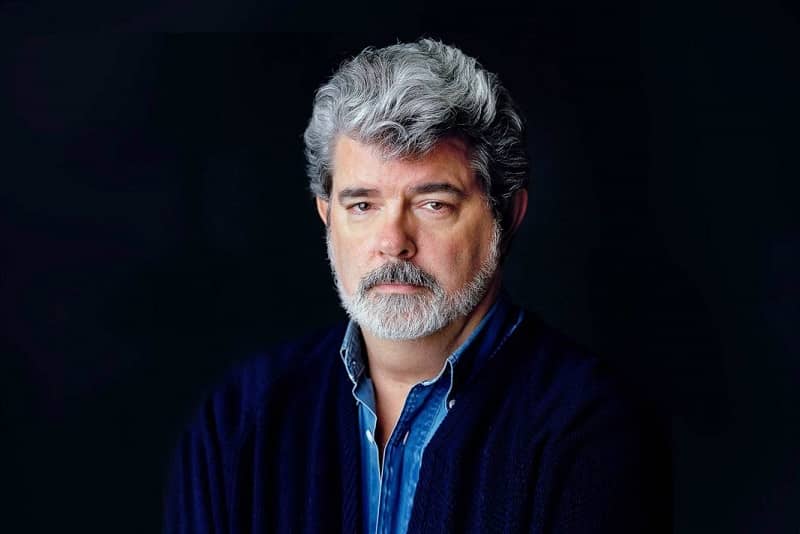
Don’t you even THINK about trash-talking Loverboy. Just. Don’t.
It’s not by any stretch of the imagination a GOOD movie, but I do still have a lot of fondness for The Black Hole, primarily due to childhood nostalgia. But it also has a pretty great score, and the Cygnus is one of my favorite fictional ship designs; and I also kind of like the way they did the black hole effect.
Saturn 3, on the other hand, which I’ve been aware of since it came out, but never actually saw until just a year or two ago, is pretty much garbage.
And let us not forget Starcrash, starring Christopher Plummer (RIP).
It’s impossible for me to forget Starcrash, Joe, as I have an autographed photo of Caroline Munro as Stella Star on the wall of my den. There can be no excuse for such behavior, so I make no excuse for it.
I met Caroline Munroe at a SF convention in Britain in 1989, I think it was. She was astonishingly beautiful. And, hey, Maximillian Schell was great in THE FRESHMAN.
I think both these movies deserve one viewing if you’re into SF movies, THE BLACK HOLE for the Cygnus and SATURN 3 for Hector (I’m pretty fond of the scene where he puts himself back together).
I’m glad Ernest Borgnine still had Cabbie and Mermaid Man ahead of him. Hate to think of the guy from Marty, The Wild Bunch, and Poseidon Adventure going out on that off-key note.
Great piece, T.P.!
‘Like a sinkfull of dirty, potato peel-flecked water slowly making its way down a clogged drain’, eh? Well I laughed!
I do remember word-of-mouth being that this film was an unwatchable turkey (plus people had difficulty reconciling a ‘dark’ SF movie with Disney) although – to the best of my memory – it still turned up in a few cinemas here.
Re Saturn 3. My memory of this film is that Douglas wanted the robot to go trundling along the spaceship’s corridors declaiming his virility (I kid you not) but that his star-power wasn’t quite enough to make this happen.
Both films seem to be variations on familiar SF tropes – ie, ‘Black Hole’ sounds a lot like ‘Event Horizon’ for example, while ‘Saturn 3’ sounds like ‘Android’ (which I actually wouldn’t mind seeing again some time).
There is a TON of this stuff on Netflix.
Saturn 3 very clearly had the previous year’s Alien in its sights, just as The Black Hole was trailing Star Wars. Again, the nameless pack of studio execs watched the movie and learned none of the lessons.
I saw The Black Hole when it opened… The theater was not packed and the finale was something of a relief to me–but, amazingly, nobody else was laughing. Both of these movies have great musical scores (on their own) although The Black Hole was not helped at all by the John Barry music that was wholly inappropriate for the film.